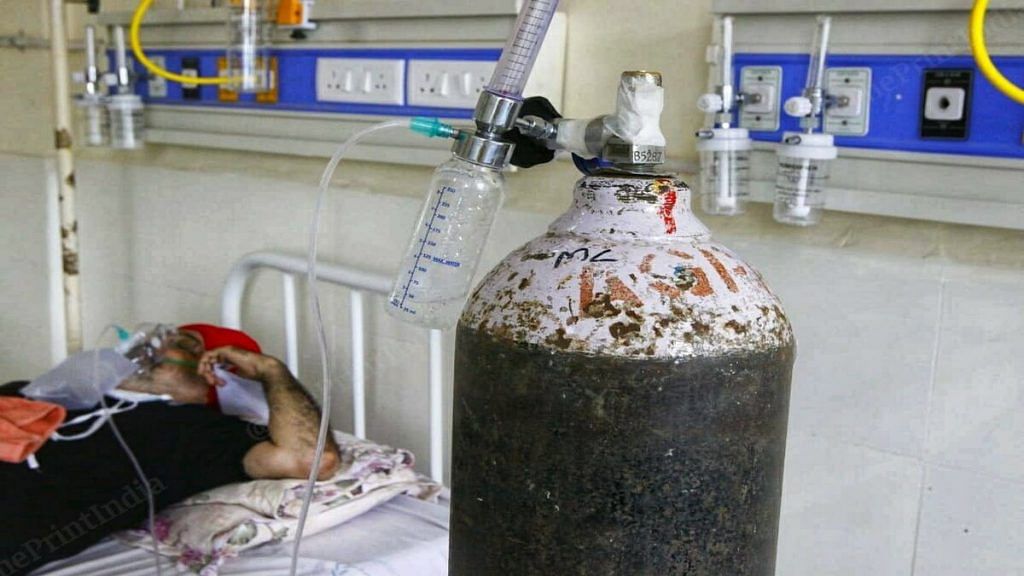There was a cruel irony this week in NASA’s announcement that it produced oxygen for the first time on another planet. Despite the ‘out of this world’ advances in science and technology, a nation of 1.3 billion people is scrambling to find oxygen for Covid patients dying every hour.
Over three lakh people are testing positive for Covid-19 on a daily basis in India — the highest count of daily infections in the world — and more than 2,000 deaths being recorded on average every day, many more being missed.
But even if you were not looking at the daily bulletins and news coverage, a look at Indian Twitter feed and WhatsApp groups confirms what the officials had been denying — the acute shortage of beds with oxygen. If walking migrants on empty roads was the defining image of the first wave of coronavirus pandemic, ambulances with patients gasping for oxygen lined up outside hospitals across the country is of the second.
And that is why oxygen shortage is the ThePrint’s Newsmaker of the week.
Also read: N-E Delhi hits ‘new low’, deputes 6 govt teachers to assist in Covid bodies management
Denial is always the first step
At first, the pleas for oxygen came from people asking for help for their family members. Even as social media users organised themselves into networks that helped patients arrange what they needed, authorities were busy telling the media that there was ‘no shortage’.
If this wasn’t bad enough, soon representatives from hospitals started to tweet for help. Frequent tweets by hospital authorities, who it is assumed have dedicated channels for communication with the government and other stakeholders, symbolise the desperation of the healthcare system.
Access to the life supporting gas became a turf war as Haryana home and health minister Anil Vij tried to stop the transport of oxygen from plants in the state to Delhi. While this particular issue was said to have been resolved with the intervention of the central government, other hospitals continue to face crisis.
Even the courts had to step in as Max hospital Parparganj claimed shortage of oxygen — another sign of failure of crisis management.
The Supreme Court Thursday took suo motu cognisance of issues related to the management of the Covid-19 pandemic in the country. Although the matter was adjourned Friday after top layer Harish Salve withdrew as amicus curiae for the case.
Also read: Concerns about false RT-PCR negatives flagged at high-level govt meeting on Covid
Was the crisis unforeseen?
A look at the Google trends for the word ‘oxygen’ shows that its demand has been closely mirroring the rise and fall of the Covid wave in India.
While initially, there was a fear that India would run out of ventilators if cases in the country surged, doctors soon realised that rather than ventilators, it was oxygen that would save lives. However, preparing sufficient oxygen supply chains seems to have gotten left out of the scheme of things.
And you can’t even say it wasn’t flagged.
As far back as November last year, a panel of officers set up by the Centre for planning Covid response had flagged that India could face a shortage of oxygen supplies.
However, as the cases came down, the government had all but declared the pandemic over. Despite the fact that cases began to increase by the end of February, Prime Minister Narendra Modi continued mass rallies in West Bengal, while also allowing the massive Kumbh Mela in Uttarakhand.
As a result we are now looking at what can no longer be described as a ‘curve’ — it is a cliff. A nearly straight vertical line that keeps climbing. And as cases climb, so do the number of people needing hospitalisation — and oxygen. As it happens with climbing peaks, the cliff of Covid is leaving India short of breath.
Also read: B.1.117 to B.1.618, India has many Covid variants causing infections. Here are the dominant ones
Why Covid patients need oxygen
Severe Covid is characterised by falling oxygen levels, because the cells that help transfer oxygen from the lung to the blood are inflamed. Some of the lungs’ tiny air sacs also get filled with fluid, which means that this healthy oxygen exchange gets impaired.
A Bollywood actress suggested, in what was perhaps a well-intentioned advice, that people plant more trees for oxygen. While that may be a solution to a whole different set of problems such as climate change, here’s why plants won’t bring relief. Oxygen from plants mix with the air we breathe on Earth, which contains 78.09 per cent nitrogen, 20.95 per cent oxygen, 0.93 per cent argon, 0.04 per cent carbon dioxide, and small amounts of other gases. For a healthy body, the 21 per cent oxygen is good enough, but impaired lungs need concentrated oxygen to keep blood oxygen levels steady.
That is where oxygen cylinders come in. Approved Covid treatments like dexamethasone can only be administered when the blood oxygen levels are stable.
Every minute, India is losing lives to Covid. And we have lost the window of opportunity to scale up technologies.
In the present scheme of things, most Covid patients are relying on good samaritans on social media to save lives. Meanwhile, doctors are recommending prone positioning at home to improve oxygen levels in case medical care is not immediately available.
Views are personal.
Edited by Anurag Chaubey
